Security Forces put to the test
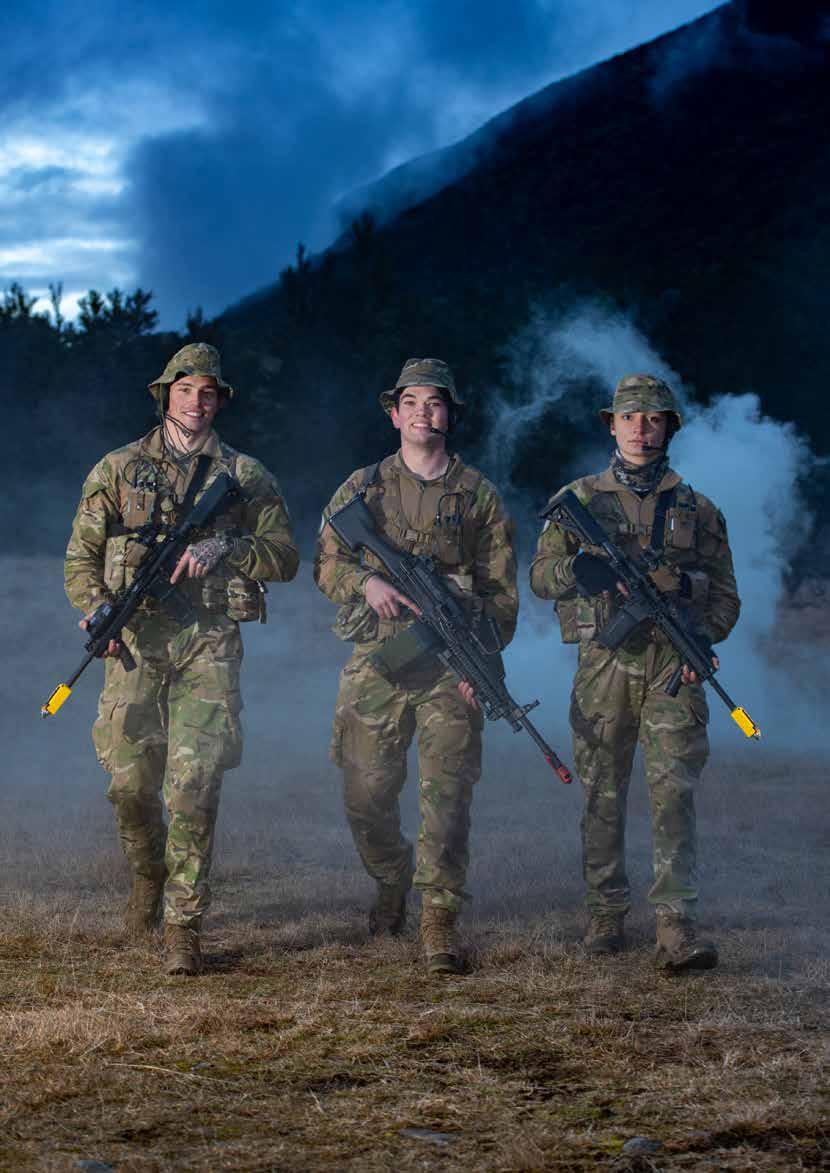
#261 SEP | 23
Flying high in major exercise
Fisheries operation success
Invaluable alpine training
OUR MISSION
The RNZAF will provide New Zealand with relevant, responsive and effective Air Power to meet its security interests.
OUR VISION
An agile and adaptive Air Force with the versatility essential for NZDF operations.


COVER: Security Forces trainees put to the test
PHOTOGRAPHER: PO Chris Weissenborn
Published by Defence Public Affairs HQ NZ Defence Force Wellington, New Zealand
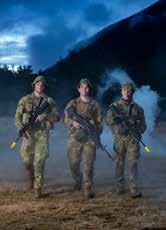
Editor Rebecca Quilliam
Email: airforcenews@nzdf.mil.nz
Design and Layout Defence Public Affairs
Printed by Bluestar Private Bag 39996, Wellington
Distribution Email: airforcenews@nzdf.mil.nz
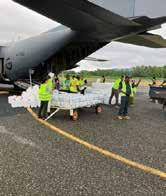
Editorial contributions and ideas are welcomed. They can be emailed directly to the Editor and do not need to be forwarded through normal command chains.
Contributions need to include • writer’s name, rank and unit • photos provided separate from the text – at least 300dpi.
Air Force News will hold the copyright for submitted articles or photographs it publishes. Articles and photographs published in Air Force News cannot be published elsewhere without permission.
Contents
News 20 Remembering Iran deployment 26 Maintenance Licensing 32
ISSN 1175–2337
Look Skywards Regulars 03 First Word 22 #FacesOfYourForce 24
Heritage 28 Sport 33 Notices 34 Photo of the month NZDefenceForce NZAirForce
ACM Sir Keith Park –
Our
04 Air Force command change 05 Aid to Bougainville after eruption 06 Fisheries operation success 08 Flying high in major international exercise 12 Alpine training invaluable for helicopter crews 16 Security Forces trainees put to the test 18 Island Chief 2 | AIR FORCE NEWS #261
First Word
What a turbulent time we live in. Covid-19, regeneration, introducing new capabilities, coping with regulatory change and a return of tempo have dominated our battle rhythm since 2020. Attrition caught us smugly looking at our Navy and Army comrades reeling from their losses. The worsening economic environment is impacting our aviators and their whānau. That said, in this First Word, I will be cautiously optimistic and talk about the positive things happening in Defence. We deployed our Humanitarian Aid and Disaster Relief capabilities into the Pacific and again domestically in response to the national flooding events. We exercised our capabilities on Exercise Mobility Guardian and, again, on Exercise Talisman Sabre. No. 5 Squadron successfully transitioned to Ohakea and is delivering outputs while continuing to introduce the remaining roles. No. 42 and 40 Squadrons conducted fisheries operations and covered National Contingency flights, respectively.
Sport and professional development has returned to camps and bases, a novel experience for some. Numerous policy interventions, including the remuneration package, have eased our condition.
We have adapted and demonstrated a fair amount of resilience to get here. For those who have persisted, this is a phenomenal effort and a testament to your competence and attitude to service and duty. We might be at a turning point with attrition declining, recruiting improving, and re-enlistments rising. Paraphrasing the Chief of Air Force at the recent Town Halls, we have been understandably reflecting on our current state.
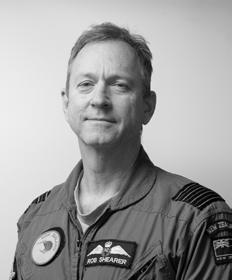
In July, the Ministry of Foreign Affairs released the strategic foreign policy, followed quickly by a threat assessment from NZSIS. The Government released the National Security Strategy (NSS) in a first for New Zealand. Right out of the realist playbook, the Minister of Defence stated, “We take the world as it is, not how we would like it to be.”
We are seeing a robust strategy formulation process in action. In response to the NSS, the Defence Force dropped the Defence Policy Strategy Statement (DPSS) and Future Force Development Principles under the overarching Defence Policy Review. In these documents, you won’t find a Christmas tree decorated with tangible capabilities. Instead, the strategy process continues as we seek to match aspirations with capabilities. We can see these aspirations rhyming in the various security announcements.
The NSS contains a compelling vision of a secure and resilient Aotearoa, protected as a free, open, and democratic society for future generations. The DPSS outlines the threats, our Defence interests and objectives. It states a strategy of making sense of our environment, partnership and acting with credible, combat-capable deployable forces. For this aviator, the strategy signals a valuable return to increased presence and operations in the Pacific. I encourage you to read these documents. As members of the profession of arms, we need to think critically about the implications of this strategy process because they provide context to the decision-making and resource allocation for reinvesting in Defence over the next 10 years.
FIRST WORD | BASE COMMANDER BASE OHAKEA GROUP CAPTAIN ROB SHEARER B Y
“The time is right to lift our gaze to the horizon to reimagine the future Defence Force. A future that looks very interesting, given the recent flurry of security announcements.”
AIR FORCE NEWS #261 | 3
Command change for Royal New Zealand Air Force
Air Commodore Darryn Webb, MNZM, will take command of the Royal New Zealand Air Force following the appointment of Air Vice-Marshal Andrew Clark to the role of Director-General Government Communications Security Bureau (GCSB).


Air Commodore (AIRCDRE) Webb will be promoted to the rank of Air Vice-Marshal and will lead the Air Force from October 2 until the formal appointment of a Chief of Air Force in 2024.
Chief of Defence Force, Air Marshal (AM) Kevin Short, acknowledged AIRCDRE Webb’s distinguished career that has spanned more than 33 years of service.
“AIRCDRE Webb has a wealth of operational, command and staff experience, gained over his career. He is an exceptional leader and I look forward to working with him.”
Since joining the Air Force as a pilot in 1990, AIRCDRE Webb has accumulated more than 6000 hours of flying, conducting multiple operational missions and deployments.
He has commanded Air Force units at every level and held strategic portfolios including Defence Capability and Strategic Commitments and Engagements.
Beyond Defence, AIRCDRE Webb was Head of Managed Isolation and Quarantine, seconded into the All of Government response. He was appointed a Member of the New Zealand Order of Merit (MNZM) in the 2022 New Year Honours list for services to the Defence Force in recognition of this role.
The Public Service Commissioner announced the appointment of current Chief of Air Force Air Vice-Marshal (AVM) Clark to the position of Director-General of the GCSB and Chief Executive.
AVM Clark’s appointment will see him lead the GCSB, which contributes to national security by providing cyber security and the foreign intelligence required to protect and advance New Zealand’s security, defence, economic and other interests. The Director-General is also the Government Chief Information Security Officer.
“It is a well-deserved move for AVM Clark who has served the Defence Force with distinction for more than 36 years, culminating in the role of Chief of Air Force since 2018,” AM Short said.
“He has been a talented and thoughtful leader. Air Vice-Marshal Clark has led the RNZAF skilfully during difficult times, and leaves the Service well placed for the future.”
| LEADERSHIP
4 | AIR FORCE NEWS #261
Aid to Bougainville after eruption
A C-130 Hercules has gone to Bougainville, Papua New Guinea, carrying aid supplies following a volcanic eruption which has affected more than 8000 people.
The deployment followed a request from Papua New Guinea Prime Minister James Marape for international partners to support the Autonomous Government of Bougainville and the Government of Papua New Guinea as they assessed the damage and respond to emergency needs.
Ash plumes and other volcanic effects affected surrounding communities. While no deaths or injuries were reported, ash fall posed challenges for food and water security.
The PNG National Disaster Centre (NDC) advised that the total number of people impacted was more than 8000, with approximately 3500 people displaced to two evacuation camps. The number of displaced people was expected to increase.
Commander Joint Forces New Zealand Rear Admiral (RADM) Jim Gilmour said the Defence Force remained committed to supporting Pacific neighbours when called on to help.
The C-130 arrived in Buka, Papua New Guinea with about 7000kg of supplies on board, after leaving Base Auckland at Whenuapai on the morning of August 10.
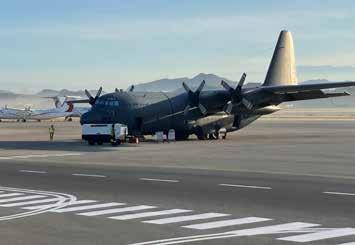

“Our C-130 flew those essential supplies in to Buka, which would help meet some of the basic needs of those affected by the volcanic activity. As always we stand ready to provide further assistance if called upon to do so,” RADM Gilmour said.
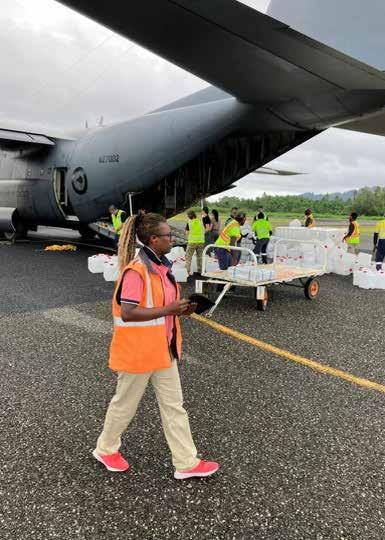
The supplies included lighting, generators, hygiene and family kits, water containers, water purification tablets, temporary shelters and tarpaulins.
“Aotearoa New Zealand’s thoughts are with the people of the Autonomous Region of Bougainville, Papua New Guinea, who have been significantly impacted by ongoing volcanic activity on Mt Bagana since July,” Secretary of Foreign Affairs and Trade Chris Seed said.
OPERATION S |
AIR FORCE NEWS #261 | 5
Fisheries operation success
The P-8A Poseidon has completed its first operation in the South Pacific relating to illegal fishing. Crews contributed to the missions success with dozens of alleged breaches identified.
Fisheries compliance officers from Aotearoa New Zealand, Australia, Fiji, France, and the United States detected nearly 40 alleged breaches of high seas rules during a major South Pacific patrol.
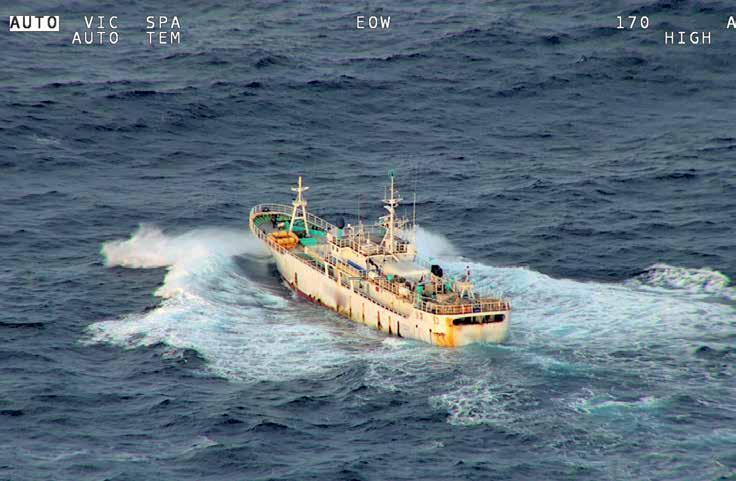
Called Operation Nasse, the fisheries patrol covered a vast area from the Tasman Sea eastwards to the south of the Cook Islands. It wrapped up last month after three weeks at sea and surveillance from the air, with the main aim being to combat Illegal, Unreported and Unregulated (IUU) fishing throughout the South Pacific Ocean.
IUU fishing is estimated to cost the Pacific region millions of dollars in lost revenue each year.
“This operation was vital to our plan and vision to knock out all forms of illegal fishing, which seriously undermines sustainable fisheries management, threatens food security, and creates an unfair playing field for legitimate commercial fishers,” said Fisheries New Zealand’s director of fisheries compliance, Steve Ham.
“Fisheries patrols of this level are a key initiative in detecting illegal fishing because, with eyes on the sea and from the sky, our fishery Officers can legally gain full access to a vessel’s catch records and fish holds.
“Our international team boarded and inspected more than 20 vessels at sea, along with monitoring the movements of 120 other vessels during our air surveillance work. We found 38 alleged breaches – many of these were about non-compliant seabird mitigation gear being deployed.”
| OPERATIONS
6 | AIR FORCE NEWS #261
Other alleged offences included incorrect flags being displayed, failure to provide vessel monitoring data, maritime pollution and poor handling of sharks and stingrays.

Commander Joint Forces New Zealand Rear Admiral Jim Gilmour said the Defence Force worked closely with international partners deploying vessels, aircraft, and trained personnel alongside fishery compliance officers on various operations to detect and deter IUU fishing.

“This was the first time the Royal New Zealand Air Force’s new Poseidon P-8A aircraft had been deployed on Operation Nasse, with the crew providing valuable information on the activities of fishing vessels during their patrols,” he said. “IUU fishing destroys livelihoods and the sustainability of fishing resources, and more broadly undermines regional security. It is critical that we continue to protect marine resources from those who believe the rules don’t apply to them.’’
Many of the rules are designed to protect not just fish stocks from exploitation but also seabirds and important marine animals, such as shark species and turtles.
Operation Nasse is an annual patrol and along with aircraft and vessels from the NZDF, the United States Coast Guard provided a C-130 aircraft, and Australia and France also provided sea patrol vessels.
“This year also saw Fiji participate for the first time in the international patrol,” said Mr Ham.
“Bringing Pacific Island nations into the forefront of these patrols to gain experience is something we want to continue. Pacific Island nations and their communities stand to lose economically because of illegal fishing on the high seas and we are behind them all the way in supporting frontline port inspections of fishing vessels.
“The Ministry for Primary Industries works closely with the relevant flag states, and we’ll be referring the 38 alleged breaches of high seas fishery rules to these states for urgent investigation.
“Historically, flag states have responded and taken action when their vessels have been found to have breached these laws with fines at the more serious end of offending at over US$1 million on one occasion for intentionally misreporting tuna,” Steve Ham says.
OPERATION S |
PHOTOS Sea and air surveillance aims to detect IUU fishing activity
“This was the first time the Royal New Zealand Air Force’s new Poseidon P-8A aircraft had been deployed on Operation Nasse, with the crew providing valuable information on the activities of fishing vessels during their patrols.”
AIR FORCE NEWS #261 | 7
– Rear Admiral Jim Gilmour
Flying high in major international exercise
Air Force personnel have proved their worth in working alongside other militaries during a large-scale combat exercise in Australia. They formed part of an Anzac unit contributing to an aviation battle group, which supported air mobile operations and troop movements.

| EXERCISES
WORDS | SQUADRON LEADER KIRI OHLSON PHOTOS | CORPORAL NAOMI JAMES
8 | AIR FORCE NEWS #261

EXERCISE S | AIR FORCE NEWS #261 | 9
About 300 New Zealand Defence Force (NZDF) personnel have returned home after participating in the largest-ever iteration of Exercise Talisman Sabre, which recently ran in Queensland and involved about 30,000 military personnel from 13 countries.
Three NH90 helicopters and 50 personnel, including aircrew, aircraft maintenance, safety, communication and information systems, intelligence, medical and logistics, also participated in the exercise, deploying in Townsville.
The rotary wing task unit formed a part of an Anzac task unit combined with MRH-90 aircraft. This created the opportunity for line pilots to demonstrate operational expertise and build experience conducting tasks such as troop movements, troop briefing and air mobile operations.
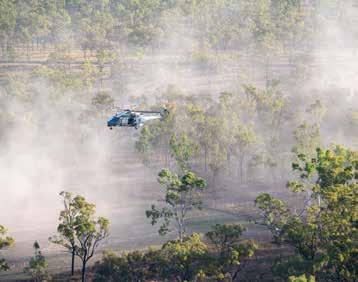
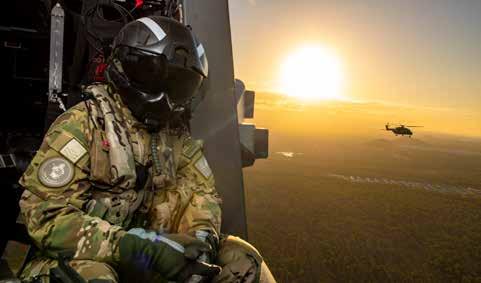
This required them to align standard operating procedures, and identify differences in order to operate efficiently together. The aviation battle group also included Australia and the United States. In the training area our Air Force personnel also worked with Indonesian, German, Australian, His Majesty’s Armed Forces, United States, and New Zealand soldiers.
Training objectives for the unit included integration with large scale coalition forces to develop an understanding of the battlespace and airspace management, integration of ground units, use of special instructions that detail how to operate, right down to the little details.
The integration from the enabling trades was significant. The intelligence team had slightly different skillsets to other nations, which allowed mutual learning. They were able to provide detailed individual updates to help build the crew’s understanding of the tactical picture and the threat picture.
Air Force Communications and Information Systems technicians rigged up high frequency aerials for the whole battle group and they worked hard in the background to liaise with partners to ensure communications were interoperable between nations.

Maintainers and logisticians collaborated with Australian Army aviation counterparts and shared procedures relating to aircraft serviceability and how to handle a downed aircraft in a combat environment.
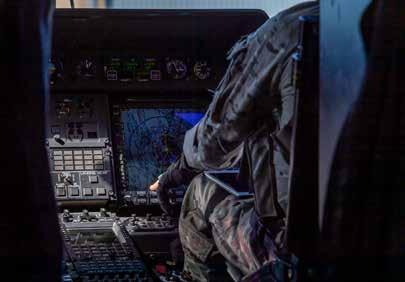
| EXERCISES
10 | AIR FORCE NEWS #261
Squadron Leader (SQNLDR) Andy Scrase was the Rotary Wing Task Unit detachment commander.
“As a rotary wing unit we are a supporting asset for the ground manoeuvre forces so we remain ready to be tasked as they develop their courses of action.

“The most enjoyable part of the exercise was being a part of formation packages with multiple aircraft types, the large airmobile operation that we took part in had twelve aircraft, and six different types including the Apache, NH90, ARH, MRH-90, UH-60, and Chinooks,” SQNLDR Scrase said.
“The crews have had an opportunity to see how they stack up against some of our major partners and get some confidence knowing that they stack up really well.”
Lieutenant Colonel Jacob Murray, the Defence Force Senior National Officer for the exercise, said the Defence Force’s purpose was to keep New Zealand safe and secure.

“To achieve this, the core role of the Defence Force must be the readiness to conduct combat operations. The performance of our team demonstrates the professionalism of our people and the quality of our training systems.”
The exercise was also the first time New Zealand and Australia have exercised together since the signing of the Plan Anzac bilateral service cooperation plan, which formalises Army to Army cooperation across strategic engagement, capability, training, readiness and common personnel issues.
“This has given us the chance to observe the Australian Army’s application of its doctrine in a large-scale combat-focused activity,” said Assistant Chief of NZ Army for Training, Colonel Aidan Shattock.
“The analysis of these observations will inform our doctrinal alignment with Australia and define our future approach to training and tactics.”
The exercise is a bilateral biennial Australian-hosted and United States supported combined exercise, focused on the planning and conduct of a high end, mid-intensity warfighting scenario.

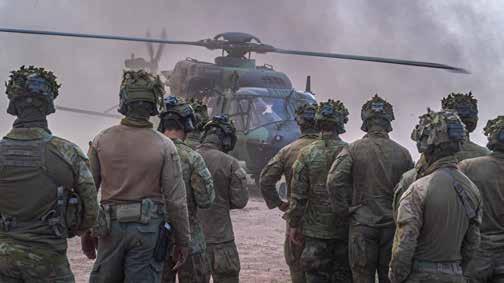
EXERCISE S |
AIR FORCE NEWS #261 | 11

| EXERCISES 12 | AIR FORCE NEWS #261 12
Alpine training invaluable for helicopter crews
The mountainous terrain of the Marlborough Region has recently provided the perfect landscape for SH-2G(I) Seasprite helicopter training. The rugged landscape was a far cry from the nautical environment the aircrew is used to.

EXERCISES |
AIR FORCE NEWS #261 | 13
WORDS | SIMONE MILLAR PHOTOS | PETTY OFFICER CHRIS WEISSENBORN
More than 90 people supported Exercise Bluebird, which included Royal New Zealand Navy flight crew from No. 6 Squadron along with Air Force operations, communications and security personnel.
The exercise was designed to train helicopter crews in mountain flying operations. It also supported the Department of Conservation (DOC) and the New Zealand Land Search and Rescue team (LandSAR) with identifying avalanche risks, reconnaissance and training in airborne search procedures.

“The mountain ranges in the Marlborough region are perfect for our training. They provide all sorts of different valleys, bowls, pinnacles and ridges to fly around,” said Detachment Commander, Lieutenant Commander (LTCDR) Terry Rawhiti.
“The biggest challenge we face every time we conduct mountain flying training is becoming reacquainted with the environment and getting a healthy dose of appreciation of the fact that we are, by far, not the biggest thing in the sky.
“Other challenges are the changeability of the weather in the mountains and the remoteness of the operating environment, both of which we train for prior to arriving on station,” he said.
The SH-2G(I) Seasprite is a maritime warfare-capable helicopter, but it is essential that crews train in mountainous terrain in order to familiarise personnel in high altitude and cold weather flying operations.

“No. 6 Squadron conducts a wide variety of tasks in support of New Zealand’s interests,” LTCDR Rawhiti said.
“Though these operations are primarily based from Navy ships at sea, we sometimes find ourselves in mountainous environments, such as resupplying the Kermadec Islands to the North East or the sub-Antarctic Islands.
| EXERCISES
14 | AIR FORCE NEWS #261
“These operations require the Seasprite helicopter to be operated in and around mountainous terrain in some of the most unpredictable flying conditions our aircrew will experience.”
The exercise was a new experience for pilot Captain Darcy Foo, who is in New Zealand on exchange from the Royal Canadian Air Force.

“I have a bit of experience flying gliders in the mountains in Canada, but this is my first time flying a helicopter in mountainous terrain. The training will really get me to the next level and take me outside my comfort zone. You’ve got to take into account factors like wind, weather and the landscape to get in and out of some of these really tough spots.
“Training in that environment with an instructor and gaining deeper real-world experience in a controlled environment is immensely valuable. It’s a really big deal for us,” he said.
While in Marlborough, the squadron also assisted other Government agencies.
“We conducted avalanche reconnaissance flights around the Spenser Mountain Ranges to identify any potential avalanche risks in the area for DOC,” LTCDR Rawhiti said.

“We also supported the LandSAR team by conducting mountain-familiarisation flights for up to 15 staff and volunteers, including insertion and extraction into remote locations, winching and airborne search procedures to train for mountain search and rescue scenarios.”

EXERCISES |
AIR FORCE NEWS #261 | 15
PHOTOS LandSAR team winch training
Security Force’s trainees put to the test

The exercise is a Readiness Training Activity and is the first time Security Forces trainees get to put their field skills to the test and experience field-based security work as well as extended time on simulated duty.
“The exercise covers basic ground defence and soldiering skills for the defence of an air base while on high-threat operations. The training allows us some freedom of movement and the ability to use pyrotechnics and blank ammunition,” says Flight Sergeant Jim Reilly, Senior Instructor at Security Forces.
The Security Forces trade group contributes directly to preparing personnel for operational duties, and protecting Air Force assets, both on a military air base at home and while deployed overseas.
Aircraftman (AC) Amber Barclay-Williams said the exercise had given her the chance to prove her skills in ground defence.
“We take the skills we’ve learned from our military ground defence training and practise patrolling, barbed-wiring construction, combat techniques and contact drills,” she said.
After completing her training, AC Barclay-Williams hopes to join the Command and Recruit Training Squadron, with a goal to eventually work in the Youth Development Unit.
“In the past, I’ve been a mentor for an all-female youth group and have been the leader of a human rights group at school. Relating to people and teaching practical skills is what I’m good at. I’m passionate about being a good role model and making a positive difference in young people’s lives.”
| EXERCISES
Eleven Security Forces trainees have been testing their skills on exercise in the stunning but rugged environment at the Air Force property Dip Flat, in Marlborough’s Upper Wairau Valley.
WORDS
16 | AIR FORCE NEWS #261
| SIMONE MILLAR PHOTOS | PETTY OFFICER CHRIS WEISSENBORN
AC Cameron Woodhouse returned to his home ground on the exercise.
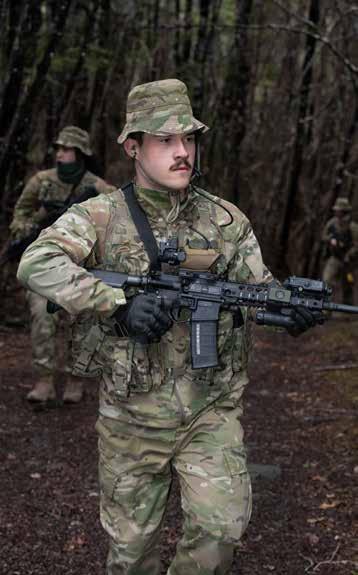
“The terrain is really special as you’re surrounded by the hills, mountains and the river. It’s a really stunning place to be,” he said.
“Growing up in Blenheim, my dad always talked about Dip Flat. It’s really special to go there with this training and relive those memories dad shared with me.”
The trade includes responsibility for identifying and mitigating threats to air operations, providing airbase protection (ground defence) and physical security at bases and preparing Air Force personnel to maintain combat readiness.
“After seeing the unique opportunities available in the Security Forces trade, I was hooked,” AC Woodhouse said.
“These opportunities include dog handling, air transport security for VIP flights, and security for overseas aircraft.
“What I enjoy about Security Forces is that junior ranks get a decent level of responsibility. There are also many leadership opportunities available very early on in my career, from something small like a safety supervisor on the range, or even a recruit instructor.
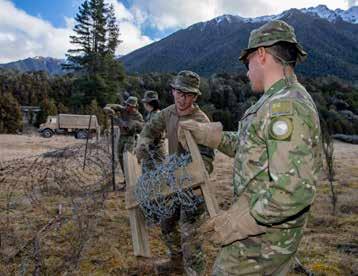
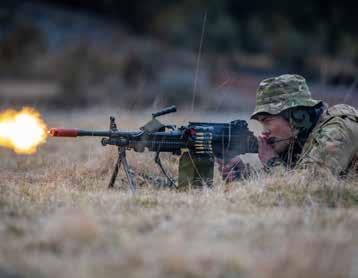
“Opportunities like this are rare in other trades and civilian jobs, which is what makes Security Forces so special,” he said.
AC Dylan McClintock has changed service from a career in the Army to Security Forces in the Air Force.
“My partner is a medic in the Air Force and my sister is an air warfare specialist. After five years of being in the NZ Army, it was time for me to do something different and progress in my skills and talents,” he says.
“Security Forces offers so many different career opportunities. I’m six months in to my RNZAF Security Forces Operator Course and I’m hoping to work with the Military Working Dog Unit at Base Ohakea, once I’ve finished my training. I love animals and I think it will be really rewarding going through the process of growth for myself and the working dog.”
“I’m able to bring skills and knowledge from my Army training to the exercise. I’ve trained in survival skills and hand-tohand combat, but this will really help me develop my leadership skills,” he says.
EXERCISES |
AIR FORCE NEWS #261 | 17
Poseidon success in Pacific fisheries mission
Operation Island Chief was a 12-day operation covering 18.2 million square kilometres of the 11 Forum Fisheries Agency (FFA) member nations’ exclusive economic zones and high seas.
It involved nearly 350 personnel from various agencies, including the Navy, Maritime Police, Air Force and national fisheries bodies across 15 involved and supporting countries throughout the Pacific.
Australia, France, New Zealand and the United States provided aerial and surface surveillance support, with three ships, five aircraft and advanced remote sensing detection technology employed.
The Air Force’s P-8A Poseidon aircraft flew a total of just over 44 hours, covering about 1.8m square kilometres of ocean.

The crew reported the activities and positions of 68 vessels to the FFA as part of the operation and the wider FFA Operation 365, which included a few days flying prior to the official start of Island Chief.
Participation in the mission was part of the overall operational release of the new aircraft and the continuation of developing the capability.
Commander Joint Forces New Zealand, Rear Admiral Jim Gilmour, said the operation was a pleasing collaboration of nations and agencies, with a common goal.
“Illegal, unreported and unregulated fishing threatens sustainable fisheries and the security and economy of our Pacific neighbourhood,” he said.
“The FFA has four significant surveillance operations each year and we are proud to commit to those, as well as support Pacific nations with separate requests for fisheries patrols, in order to protect that neighbourhood.”
As well as agencies from the FFA member nations, the operation also utilised the maritime surveillance capabilities and data intelligence analysis of Global Fishing Watch, International Monitoring Control and Surveillance
Network, Canada’s Dark Vessel Detection system, the United States HawkEye 360 system (supported by the Australian Government), Starboard Maritime Intelligence system, Pacific Transnational Crime Network and the Western Central Pacific Fisheries Commission.
|
OPERATIONS
“Illegal, unreported and unregulated fishing threatens sustainable fisheries and the security and economy of our Pacific neighbourhood.”
SENIOR COMMUNICATIONS
B Y
– Rear Admiral Jim Gilmour
ADVISER NICOLE HALLIDAY
18 | AIR FORCE NEWS #261
The Air Force’s newest aircraft has been involved in a significant multinational fisheries surveillance operation for the Pacific’s Forum Fisheries Agency.
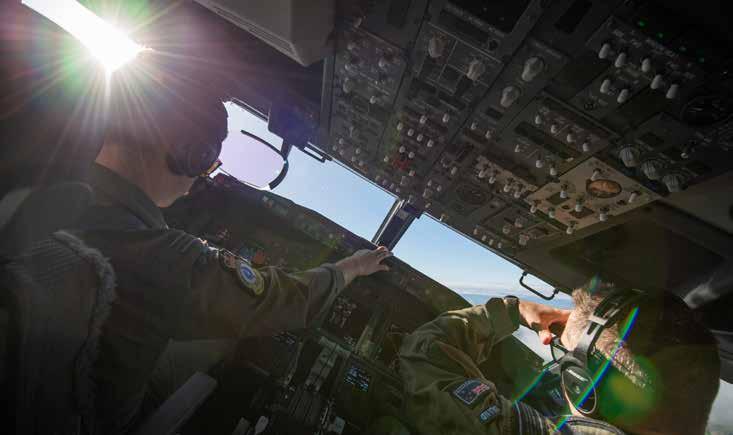

OPERATIONS | AIR FORCE NEWS #261 | 19
Remembering Iran deployment
This month marks 35 years since the Air Force deployed aircraft and personnel, alongside New Zealand Army personnel to Iran. The mission was to support the United Nations Iran-Iraq Military Observer Group (UNIIMOG), during the eight-year Iran-Iraq war.

In 1987, the year before New Zealand’s involvement, I was posted to No. 42 Squadron as a loadmaster, completing my Air Loadmaster conversion course on the Hawker Sidley Andover C MK1 in June 1988. At the time, No. 42 Squadron had nine Andovers at Base Auckland.
At this time the United Nations had brokered a ceasefire (UNSCR 598) in the Iran-Iraq war and New Zealand, along with 24 other nations committed resources to the Military Observer Group. Our commitment was an Andover, 18 Air Force personnel (two crew rotations; one for nine months and one for six months) and 10 Army personnel.
I volunteered for the first rotation and deployed with the Andover to Iran. NZ7629, which had been painted white, and had UNITED NATIONS on its side, left New Zealand on September 26, 1988 and arrived in Tehran on October 3. The aircraft was in a utility rig (clean floor with para seats fitted to the side walls) with a couple of “soft bums” and a “card table” fitted.
The route up to Tehran was as follows: Whenuapai – Amberley – Townsville –Darwin – Bali – Singapore – Butterworth – Colombo – Bombay – Dubai – Tehran. A Hercules followed us with the maintenance pack-up. The Commanding Officer was Squadron Leader ‘Dinga’ Bell. Butterworth to Colombo was seven hours – the longest flight I made in an Andover. New Zealand and the 24 other countries contributed approximately 400 personnel to UNIIMOG, split between Iran and Iraq. Countries based from the Tehran headquarters included Argentina, Australia, India, Ireland, Kenya, Sweden, Uruguay and Yugoslavia.
Flying began in earnest from October 10, 1988. We established an Air Operations Cell at the UN Tehran headquarters and set up scheduled flights to the airfields closest to the UNIIMOG personnel who were conducting monitoring duties near the border: Omidiyeh, Bakhtaran and Dezful.
| ANNIVERSARY
SQUADRON LEADER GREG PRYCE
B Y
1 20 | AIR FORCE NEWS #261
ONE Crew photo rotation one circa 1988
TWO Log Book SGT Greg Pryce

THREE RNZAF detachment patch
FOUR Circa 1988 white United Nations Andover
These flights were conducted three times a week, along with other tasking on demand. The payload was a typical air mobility mixture of passengers, cargo and mail. Regular trips were made to Dubai mostly to support the UNIIMOG Post Exchange and Baghdad, Iraq.
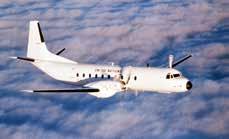
The detachment was accommodated in a three storey, 14 room villa in the northern part of Tehran. We set up a gym but the swimming pool was full of snow! Tehran at its highest point sits at 6003 feet above sea level and this was the first “White Christmas” for many of us. However once winter was behind us, the temperature picked up (a lot) and the maintenance team set about fixing the filter and we made good use of the pool. After six months there was a crew and aircraft rotation, NZ7627 replaced NZ7629.
In 1988 (if you can recall) there was no internet, wifi or cell phones. Our connection with New Zealand was the weekly mail bag collected from the New Zealand Embassy. We could also make toll calls from the land-line in the villa and I would call my mum and dad every Sunday and check-in.
Our only entertainment, apart from board games (Risk and Trivial Pursuit) was a television that was set up with a VHS video tape player and we had family and friends send us movies. Everyone was required to deploy with at least one movie and my contributions to the video library were Monty Python’s Life of Brian and Where Eagles Dare.
During the tour a group of us made a road trip and stayed overnight at Ramsar on the Caspian Sea, there were also numerous skiing trips to the Ezburz Mountains, north of Tehran. The highlight of the tour was the trip that most of the detachment made to Gallipoli for the dawn service on Anzac Day 1989.
FIVE Rotation One personnel:
Rear: LAC Pete Meier, SGT Graham Moorhead, LAC Steve McCormick, CPL Ian Atkins, SGT Greg Pryce.
Mid: FLTLT Scott Arrell, FGOFF Kerry Wilton, SQNLDR Warwick Bell, FLTLT John Jones, FLTLT Dave Rennison, F/S Dennis Kelland.
Front: SGT Steve Hourigan, LAC Kerry Tyne, FGOFF Andrew Greaves, FGOFF Adam Currey, SGT Gareth Shaw.
Absent: CPL Grant Bennie, FGOFF Phil Tigue-Umbers
We joined up with the Australian detachment and spent a great week travelling in Turkey.
Iran, following the war, was a very expensive place to live with very high inflation. Purchasing anything outside of the Post Exchange was prohibitive and buying food was problematic at times but we managed by employing a local Iranian lady to buy the food and prepare an evening meal – with potatoes plentiful and a deep fryer that was hastily despatched from New Zealand.
The Andover UNIIMOG deployment lasted a little over two years, had eight rotations (about 70 personnel in total), and ended in January 1991 after Iran and Iraq signed the formal peace agreement.

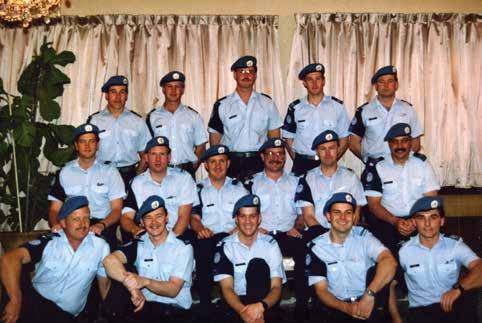
ANNIVERSARY |
2 3 4 5 AIR FORCE NEWS #261 | 21
PTI training heats up in the Middle East
EDITOR REBECCA QUILLIAM
Physical training instructor Corporal Trent Norman has recently returned from a unique opportunity, deployed on operation in the Middle East. He tells Air Force News that exercising in the extreme heat in the region was no easy task.
“The midday temperatures reached 45°–50°C. A lot of classes I ran were either early in the morning, around 6am or later in the evening, from around 5pm,” he said.
“The temperatures at those times were still sitting around minimum of 25°C overnight and as soon as the sun came up, they would start creeping up to 30°C.”
Corporal (CPL) Norman was deployed to an operational base in the region for three months where he ran training classes, sports tournaments, rehabilitation for Kiwi personnel, and facilitated adventurous activities.
Partners in the region, who had previously supplied physical training instructors, had reduced numbers to the airbase recently, asked Aotearoa New Zealand to provide someone from the trade to fill the gap.
The base that CPL Norman was deployed to was also home to coalition forces from Australia and the United Kingdom. He provided physical training to all the deployed forces and found he needed to schedule his work around personnel workloads as well as the weather.

“During the day personnel were not usually available because they were doing their jobs, plus the midday temperatures were high – many of them didn’t have vehicles to get where they needed to be, so a lot of them walked.
“It wasn’t ideal for people to be walking from work to get changed into their physical training kit to make their way to the gym, get smashed for 45 minutes or so by me, get back and go and get changed and go back to your shift,” he said.
Even after personnel had been through their acclimatisation training, factors such as dehydration still had to be managed for the safety of personnel. To mitigate this, physical training would mostly take place in an air-conditioned environment.

“When we did go outside for short runs or something, I would raise the big safety point of making sure everyone had water on hand or electrolyte sachets they could take throughout,” he said.
While the extreme heat provided challenges for CPL Norman, arriving home to a chilly Manawatū winter was no walk in the park either.
“I got sick with a bad cold within the first week of being home. I hadn’t been sick the whole time away.”
| #FACESOFYOURFORCE
B Y
22 | AIR FORCE NEWS #261
Air Force tech flies above the waves
Avionics technician Corporal Patrick Haybittle is on the hunt for Olympic Games selection as he prepares for the first qualifier, a world championships windfoil event.
Corporal (CPL) Haybittle is competing in the IQFoil class in the Allianz Sailing World Championships in The Hague, Netherlands.
IQFoil is a windsurfing class with a hydrofoil under the board. It has been newly selected as a class for the 2024 Summer Olympics in Paris.
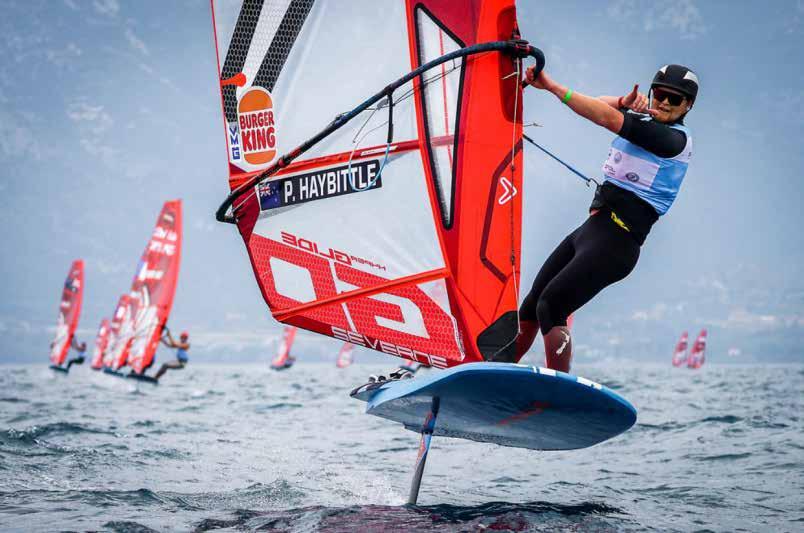
CPL Haybittle has two events under his belt this year; the Princess Sofia regatta in Palma de Mallorca – his first international event on the IQFoil – and the European Championships held in Greece. His performance as part of the Kiwi team in Spain and Greece qualified him for the Worlds. Securing a good placing there could lead to Olympic qualification.
He’s pleased with his Europe results, climbing the IQFoil rankings from 51st to 35th. It comes after having to pull out of the 2022 World Champs in Brest, France, after contracting Covid.
Fitting in training and international competition with his work hasn’t been easy. The Air Force has been very supportive, he says, but it’s still meant some stints of leave without pay.
“Ideally I’d want to be on the water five or six days a week, but I do both days in the weekend and as much as I can around work. You just have to be really smart in fitting in your training and your work.”
CPL Haybittle has been a windsurfer since age 13, and took up windfoiling as it came on the scene a few years ago.
“It’s new and exciting, and lots of people are doing it,” he said.
“I won the 2019 National Championships and I’ve been placing well in other Nationals since then. The wind range is much better with windfoiling, you can work with light winds, down to six knots. Recently I did a personal speed best of 53 km/h – which was quite exciting.” He left in July as a training partner for the Hong Kong team, then joined his Kiwi colleagues in The Hague for the World Champs.
#FACESOFYOURFORCE | ABOVE
CPL Patrick Haybittle competing at the IQFoil European Championships
EDITOR NAVY TODAY ANDREW BONALLACK B Y
Photo: Sailing Energy / IQfoil Class
AIR FORCE NEWS #261 | 23
NZ4203 Orion’s new home at the Air Force Museum of New Zealand
NZ4203 flew more than 27,000 hours during its illustrious 54-year career. It took part in hundreds of missions including search and rescue operations, anti-submarine patrols and spent thousands of hours protecting our Exclusive Economic Zone.
Air Force Museum of New Zealand Director Brett Marshall said it had been a long wait to get an Orion.
“To say we were excited would be an understatement. NZ4203 is the largest aircraft in our collection and one of the most significant. We are delighted to be able to ensure its preservation for the nation. We look forward to being able to tell the many stories associated with this extraordinary aircraft type, which served us so well for so long.’’
Built by Lockheed in Burbank California in 1966, NZ4203 entered service with the RNZAF in April 1967. In 2021 it became the first of the type to retire from service when it flew a farewell mission to land at Base Woodbourne.
The Orion fleet had given a huge amount of service over 54 years and NZ4203 deserved a happy retirement at the museum where it will be preserved as the only surviving RNZAF example of the type, as it was for its last mission –minus any sensitive military equipment, Mr Marshall said.
“NZ4203 was the first RNZAF Orion to land in Antarctica back in 2006. It has also taken part in numerous humanitarian and search and rescue missions and has been a lifesaver for many people who have found themselves needing help a long way from home.’’

The aircraft was decommissioned at Base Woodbourne in Blenheim and arrived at the Air Force Museum of New Zealand by road late last month, where it will be stored in the museum’s reserve collection hangar until an exhibition space large enough to house it can be built.
NZ4203 is 36m long, has a wingspan of just over 30m, and its tail stands 10.3m tall. “Our current exhibition halls are too small to accommodate it, so we’re busy working on plans for a new space to exhibit it,’’ Mr Marshall said. “We will keep everyone posted on our plans as they progress.’’
| OUR HERITAGE
The Air Force Museum of New Zealand is welcoming the latest addition to its collection – Lockheed P-3K2 Orion NZ4203.
B Y LEFT P-3K2
RIGHT P-3K2
24 | AIR FORCE NEWS #261
AIR FORCE MUSEUM OF NEW ZEALAND DAVID KING, COMMUNICATIONS
MANAGER
Orion NZ4203 at Antarctica on the Pegasus runway
pilot FLTLT Andrew Sunde
FLYING AN ADVENTURE FROM THE GOLDEN AGE
NZ4203 was the first P-3K2 Flight Lieutenant Andrew Sunde flew, but he also worked on the aircraft as an avionics technician before becoming a pilot.
With seven years’ service in total on the type, including 1500 hours as a pilot and co-pilot in deployments to the Middle East, Southeast Asia, Japan, and all around the Pacific, he described the ‘absolute privilege’ of flying a P-3K2 Orion.
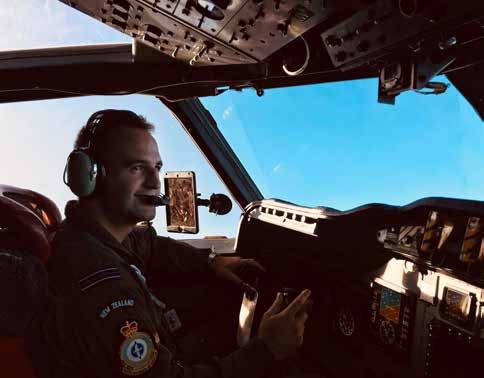
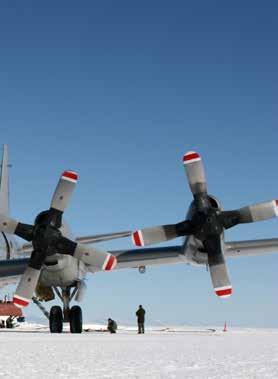
In what way were they different to fly than other aircraft?
The P3 was an aircraft from the golden age of aviation. Crews were expected to know how they worked, how things could go wrong, and you were surrounded by all the history. Flying was more of an adventure, and the aircraft gave you the sense that if you took care of it, you could expect it to take you anywhere. The P3 was great to hand fly – it had plenty of excess power (especially if it was lightweight), could easily handle turns up to 60 degrees angle of bank, and if you talk to the right people even some gentle aerobatics. When you powered up the cockpit in the morning and the engineers pushed the start buttons for the engines, it really felt like you were taking a classic V8 car out for a drive.
What was the most difficult thing to learn?
The inner workings of the four-blade constant speed Hamilton propellers! Even with the faded 1960s wall diagrams, the Service Digest magazines, and the decades of gouge’ (general knowledge) you were no match for the ability of most flight engineers to come up with yet another imaginative in-flight scenario to test your knowledge. The P3 came from an era where the mechanical complexity of everything was still expected to be understood by those operating it – and most of the flight engineers who’d been around the P3 for 30+ years could pull it apart and put it back together in their sleep.
What was your longest flight?
In my logbook I have a couple of 11-hour flights – one for a SAR (search and rescue) out near Tonga waiting overhead for the survivors to be picked up by a ship, and the other for a long-combined warfare mission in the South China Sea during an exercise. On both of these flights we had an engine shut down to conserve fuel.
Any memorable incidents?
There was one mission in the Middle East which I remember for the view. Normally the visibility in the Arabian Gulf was awful with haze, dust, and the humid air restricting visibility to less than a few miles.
One morning patrol however we climbed out over the Gulf to an exceptional day –we could see over 100 miles inland. Never before had I appreciated the barren rugged mountain ranges, contrasted between the blue sea full of ships and boats of all sizes and types, and the bright sandy coast. A scene you just are not used to from this part of the world! Do you remember anything special about NZ4203?
It was the first P3 that I flew. It was also the aircraft I flew the most during the Middle East deployment, and we took her to help with the rescue of a solo sailor in 2019 who had lost steering hundreds of miles south of Rarotonga.
Do you wish NZ4203 a happy retirement?
Absolutely – she has served far more time than we ever expected, and I think it’ll be great that she can continue to inspire future aviators or remind people of the golden age. While the P8 is a step up in speed and reliability, it won’t achieve any better results than this old girl on her final mission. She kept up.
OUR HERITAGE |
AIR FORCE NEWS #261 | 25
Maintenance licensing
Why focus on the technical workforce? Making up just under 50% of the Air Force, the technical and engineering workforce are key enablers for military air operations, and the largest identifiable group within our Service.

Various organisational and operational pressures over the last decade and a half, have taken a toll on this vital group and affected the way it’s managed and employed. Introduction of Part 66 of the new Defence Aviation Rules offers an opportunity to consider the wider issues around management, training, remuneration models, and overall structure.
With a number of initiatives already underway, the Programme team will look to build on the good work done by others while reshaping some key focus areas such as armament.
With senior leadership buy-in from a Governance Board co-chaired by Deputy Chief of Air Force and the Air Component Commander, the Programme team will be concentrating on rejuvenating the technical workforce and refocussing it towards a future-focussed employment context.
THE TEAM’S FOCUS 4R’S BEING: REPAIR the overall state of the technical workforce beginning with a review of technical employment profiles and associated task lists.
REJUVENATE Air Force technical training to deliver technical training tailored against internationally benchmarked standards.
RESTORE an appropriately empowered workforce, through reviewing existing policy settings, introducing licensing system privileges, and considering license remuneration models that link remuneration to competence rather than rank.
RETURN to a functional, repeatable, future-proofed trade management system. This will be achieved largely through the formation of suitable Trade Warrant Officer representation to centralise the strategic management of the technical workforce.
QUESTIONS?
Please contact the DARs team: WGCDR Hilton Baker (Deputy Chief Engineer), Paul Roberts (Project Management), or Mary Martin (Change Management) at DARS@ nzdf.mil.nz.
| DARS
With the foundations of our contemporary aviation system in place, the DAR (Defence Aviation Rules) Transition Programme Team has turned its focus towards the rejuvenation of the technical workforce and the introduction of Military Aircraft Maintenance Licence (MAML) system.
WING
B Y
COMMANDER HILTON BAKER & MARY MARTIN
26 | AIR FORCE NEWS #261
Enrol, check or update your details now for the 2023 General Election.
Voting in New Zealand starts on Monday 2 October.
Overseas voting starts on Wednesday 27 September.

SECURITY |
THE 2023 GENERAL ELECTION
A taste of France for the IDRC
T he Defence Blacks are in the stunning northwest of France playing in this year’s International Defence Rugby Cup (IDRC). Twelve teams from international defence forces are competing in the monthlong tournament, taking place in Brittany.

The Defence Force’s tri-service contingent includes about 30 players, nine support staff and one referee.
The competition runs from August 15 to September 12, with teams from Australia, Fiji, France, Georgia, Ireland, Japan, the Netherlands, New Zealand, Spain, Tonga, the United Kingdom and Uzbekistan competing.
Before leaving for the tournament, Air Force team member Sergeant (SGT) Ethan Bartle said his excitement level was off the charts.
“I’m very fortunate to be chosen and I’ve not taken a place in the team it for granted. It’s amazing that we get to play in Brittany – I can’t quite believe it.” SGT Bartle plays either in the lock or loose forward positions and this year’s IDRC will be his second, after playing for the team in 2019 in Japan.
The event was a great chance to meet other members of defence forces from around the world, SGT Bartle said.
“We’ll have opportunities to do school visits, mix and mingle with other defence forces and get to know them a bit better and then obviously play them on the field and share a beer with them afterwards –it’s a great way to make connections and friendships.”
The team is staying in university accommodation in a town called Pontivy. One of the challenges facing SGT Bartle will be communicating with the locals, as he admits his French is “terrible”.
“I’m going to have to learn on the plane ride over.”
Another challenge will be playing in French autumn, with the mercury reaching into the late 20s and early 30 degrees, which will be an adjustment from the crisp winter temperatures.
ABOVE
TOP RIGHT
BOTTOM RIGHT
In the current tournament, the early pool games, the team’s first match was against Fiji, followed by Uzbekistan and then Ireland.
“Here’s hoping we make it to the finals, we’ve been preparing pretty well. That’s our goal, so hopefully we’ll get there.”
Flight Lieutenant (FLTLT) Charlie Haines is heading to the tournament as a referee.
“I think I’ll be reffing at least five games in different venues around the region,” he said.
| SPORT
EDITOR REBECCA QUILLIAM B Y
Defence Black team at Base Auckland before travelling to the IDRC
SGT Ethan Bartle playing a match for the Air Force rugby team
28 | AIR FORCE NEWS #261
Charlie Haines (background) refereeing a rugby match
“It’s a very, very fortunate opportunity for me to be selected. It’s a great opportunity to meet other people.”
FLTLT Haines has about six years of refereeing experience, looking after games in Canterbury and Manawatū, when he was posted to Ohakea. But using his skills in the international competition is a different ball game, he said.

“It’s an amazing chance to meet people from different forces, how they run the game, manage the game – we are constantly learning as referees.”

SPORT |
“The biggest threat will be the Fijians who are the two time defending champions – and that’s our first game, so it’s one we’re all looking forward to as it will be a good challenge.”
AIR FORCE NEWS #261 | 29
– Sergeant Ethan Bartle
The Walk of the World
What started in 1909 with a just a handful of soldiers from the Dutch military taking a long pack-walk to build stamina, has grown to an annual international military and civilian event involving more than 47,000 participants from more than 70 nations. This year, Flight Lieutenant Mark Mieremet joined the event, now called The Walk of the World.
The four-day march starts and finishes each day in Nijmegen, the oldest city in the Netherlands and located on the Waal River, close to the German border. The participants walk four different routes of 30, 40 or 50 kilometres, lugging a pack holding at least 10kg of items inside.
The event pulls in participants from militaries around the world, but Flight Lieutenant (FLTLT) Mieremet said he was the sole participant from the New Zealand Defence Force.

“We should get more New Zealanders to do this because all our Five Eyes colleagues are participating. But it’s not really on our radar.”
Taking part in The Walk of the World had been on FLTLT Mieremet’s bucket list and having moved to Aotearoa New Zealand from Holland in 2008, it was a great opportunity return to his homeland to take part in the event and to visit family he had not seen since 2017.
The numbers of participants is limited to 47,500 people and places were snapped up so fast FLTLT Mieremet thought he’d missed out.
“Then I found out a couple of days later there were still spaces for individual, international military participants. So I grabbed a spot.
“It’s really big in the Netherlands, the city attracts about 1.5 million extra people during the walk who party beside the street and cheer people on.” All those taking part in the walk are looked after by the Dutch military, which has built a military village for the event. They look after the participants’ food, accommodation, support for during the walk, and medical care.
“I shared a room with a couple of Canadians, which was absolutely amazing. I also had Spanish, French and Austrian people in the same barrack block.”
| SPORT
EDITOR
REBECCA QUILLIAM B Y
30 | AIR FORCE NEWS #261
The walk stretches to 160km over four days – an average of 40km per day.
“Reaching the finish line was the most amazing experience. A medal is awarded to people who finish, it’s a Dutch Royal medal called the Cross for Marching Proficiency.” FLTLT Mieremet said.
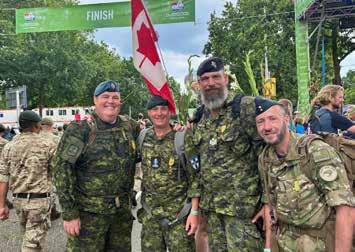
“As a military person we also had to carry 10kg per day. If the weight dips below that, you can be disqualified – it’s pretty much a pack-march.
“A lot of units use it as a training event and in some militaries it’s compulsory. But it’s also a great opportunity to use the event as a networking activity.”
Because of the sheer number of people involved, groups began the walks each day at staggered intervals. FLTLT Mieremet started his day at either 3.30am or 4.30am. The aim was to finish by 5pm.
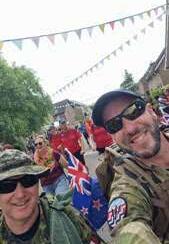

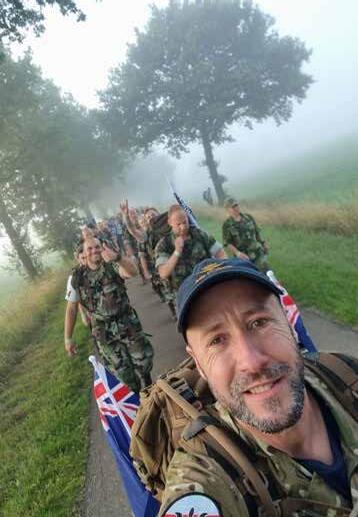
“I walked for a couple of days with my Canadian roommates and they sang as they marched and walked as a squad. I had two days where I walked by myself and you end up talking with all sorts of people – so I walked next to a Lieutenant Colonel from Austria, who shared stories with me. It’s an incredible opportunity to talk with people in military roles from other countries who you would never normally have the chance to have a conversation with.
“I was the only Kiwi and there was one Australian and people sought us out to trade patches.”
Next time FLTLT Mieremet is keen to complete the walk with a group of New Zealand colleagues.
“It would be amazing if more people from here could head over and we complete it as a group. All our allies and partners are there and it’s a great opportunity to network in a social environment.”
SPORT |
“We should get more New Zealanders to do this because all our Five Eyes colleagues are participating. But it’s not really on our radar.”
AIR FORCE NEWS #261 | 31
C ommemoration Sir Keith Park – Look Skywards
On his 70th birthday in 1962 a leading newspaper declared Air Chief Marshal Sir Keith Park one of the 10 greatest New Zealanders, a man of unparalleled strategic and tactical leadership, and a humanitarian with commitment to civic duty.
Park was an ace fighter pilot in WWI and Royal Air Force leader in WWII who helped saved London in the first victory of WWII—the Battle of Britain.
Look Skywards is a project in Park’s home town of Thames to gain greater recognition and acknowledgement for Sir Keith Park. We believe that the inspiration of his leadership, morals and ethics makes him a role model for all young New Zealanders. Park was not only a significant and successful wartime leader, he was a futurist, environmentalist, humanitarian and not the least compassionate towards those he led and worked with.
In his book “The Most Dangerous Enemy” Stephen Bungay stated: What Park achieved in the Battle of Britain is in itself enough to place him amongst the greatest commanders of history. But his performance in 1940 was not one-off.
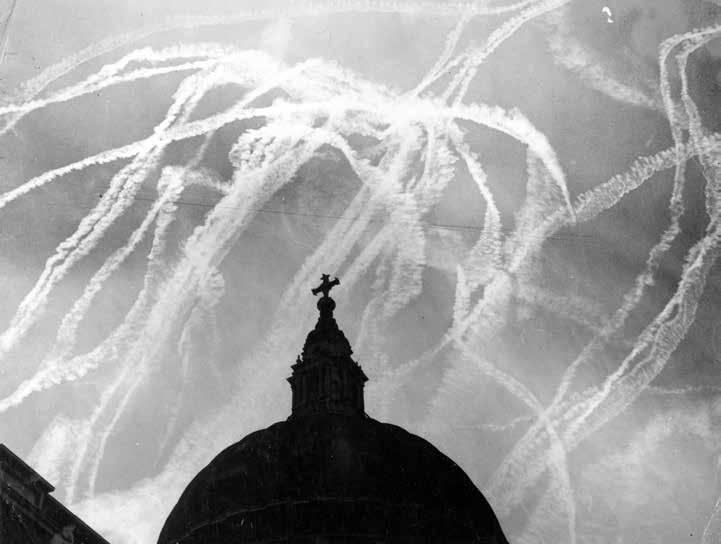
In 1942 in Malta, Park took the offensive and turned Kesselring’s defeat into a rout. After that, he directed air operations that enabled Slim to expel the Japanese from Burma. He was adept at offence as he was at defence, and like Wellinton, he never lost a battle. His record makes him today, without rival, the greatest fighter commander in the short history of air warfare.”
The Look Skywards project creates a memorial to Sir Keith at the Thames Airfield. Stage one, a full-size, replica Hurricane has been completed. Stage two, a 2.3m bronze statue of Park by internationally renowned sculptor Joanne Sullivan is partially funded and complete. It’s scheduled unveiling is due to happen at the Thames September Battle of Britain Commemorations, 2024.

| COMMEMORATION
WORDS
| GEOFF FURKET
“Sir Keith Park showed great integrity of character, simplicity and graciousness in life. He never waivered in his steel-like sense of duty, which he exercised at whatever personal cost.”
– Very Rev’d J. O. Rymer, Dean of Auckland 1975
32 | AIR FORCE NEWS #261
EOD EVALUATION WEEK
E Sqn (EOD), 1NZSAS Regt is requesting nominations for the upcoming EOD trade Evaluation. Successful candidates will be fit, motivated, and highly disciplined members of the military capable of decisive action in complex and challenging environments. You will also meet the following minimum requirements:
• Hold the rank of Private (Band 4) or equivalent
• Have a full class one vehicle licence
• Hold a Confidential vetting security clearance
• Have a minimum medical grade of A4, G2, Z1 (RFL minimum G2)
• Complete the EOD evaluation week and an evaluation by an NZDF psychologist as suitable to operate as an EOD team member.
If you want to find out more or apply, visit http://org/nzsof/LP/Recruiting.aspx and download your AFNZ 3 today. For further information, please contact SSM, E Sqn (EOD). ESQN.EOD.SSM@nzdf.mil.nz Nominations close 18 September 2023.
EOD Evaluation week 9–13 October 2023.
FOREIGN MILITARY SALES & CONTROLLED TECHNOLOGY OFFICE (FMSCTO) NEW TRAINING SUITE!
The FMSCTO, on behalf of Commander Logistics and Defence Supply Chain Management (DSCM) is proud to announce a BRAND NEW full suite of training courses available on the NZDF Learning Management portal for self-nomination.
The FMS & CT courses are designed to bridge the gap in organisational knowledge and are available to NZDF, MoD and GCSB personnel.
ONLINE COURSES:
• D67022 FMS & CT Overview (CBT available from the comfort of your own cubicle or home office)
• D67028 FMS &CT Governance (ideal for decision makers to understand the impact of FMS & CT decisions)
FACE TO FACE COURSES:
• D67023 FMS Fundamentals (Basic course requirement for all other courses)
• D67024 FMS Process Management Competency
• D67025 NZDF FMS Financial Process Competency
• D67026 End Use Management
• D67027 Export and Import Regulations
For further information please contact the DSCM Training Coordinator and Planner: harriet.newman@nzdf.mil.nz.
As a past or present aviator of the Royal New Zealand Air Force there are a number of organisations designed to support you in a variety of ways.

These include financially, rehabilitation services, workplace support, support for you and your family in case of illness, injury or death, and keeping in touch with old colleagues.
Please look into these organisations for support you might need:
www.missingwingmantrust.org.nz

Notices
SUPPORT ORGANISATIONS
0800 483 8372 or +64 4 495 2070 www.veteransaffairs.mil.nz
Royal New Zealand Air Force Association Inc. rnzafanatsec@gmail.com PO Box 164, Kirwee 7543
AIR FORCE NEWS #261 | 33
I was lucky enough to have the opportunity to photograph all four of our RNZAF P-8A Poseidons, that were sitting out on the flight line together.
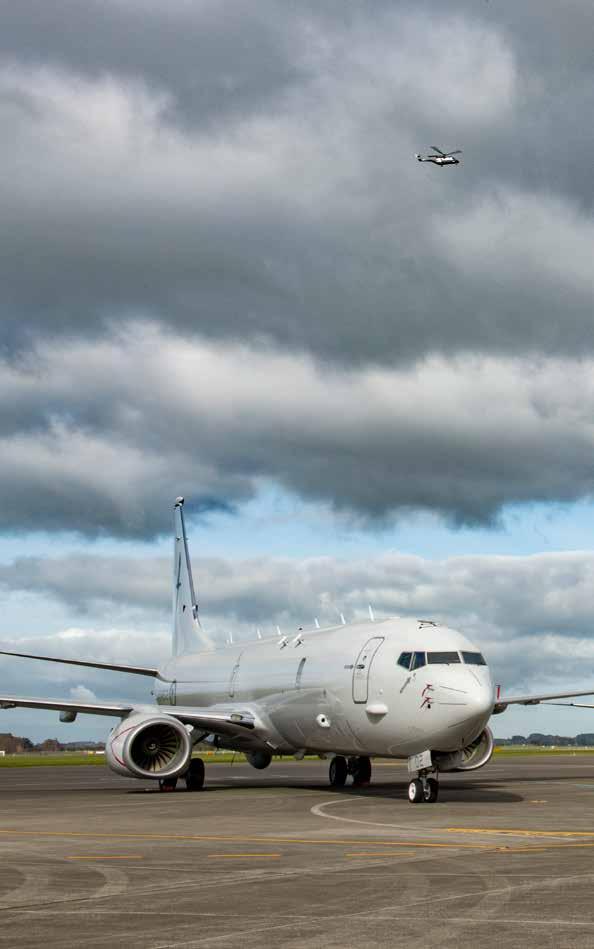
It was a special and rare occasion to be able to get all four together as usually at least one would be out on tasks or another would be undergoing scheduled maintenance.
It was a busy day for flying at Base Ohakea, with NH90 helicopters and T-6C Texans buzzing around the skies in the background.
This NH90 managed to time it perfectly, flying into view just as I took the shot, creating the perfect image to showcase not only of our new fleet of P-8A aircraft, but also the busy life at Base Ohakea with our aircraft capabilities sharing the skies.
| PHOTO OF THE MONTH
CORPORAL MADDY BUTCHER B Y 34 | AIR FORCE NEWS #261
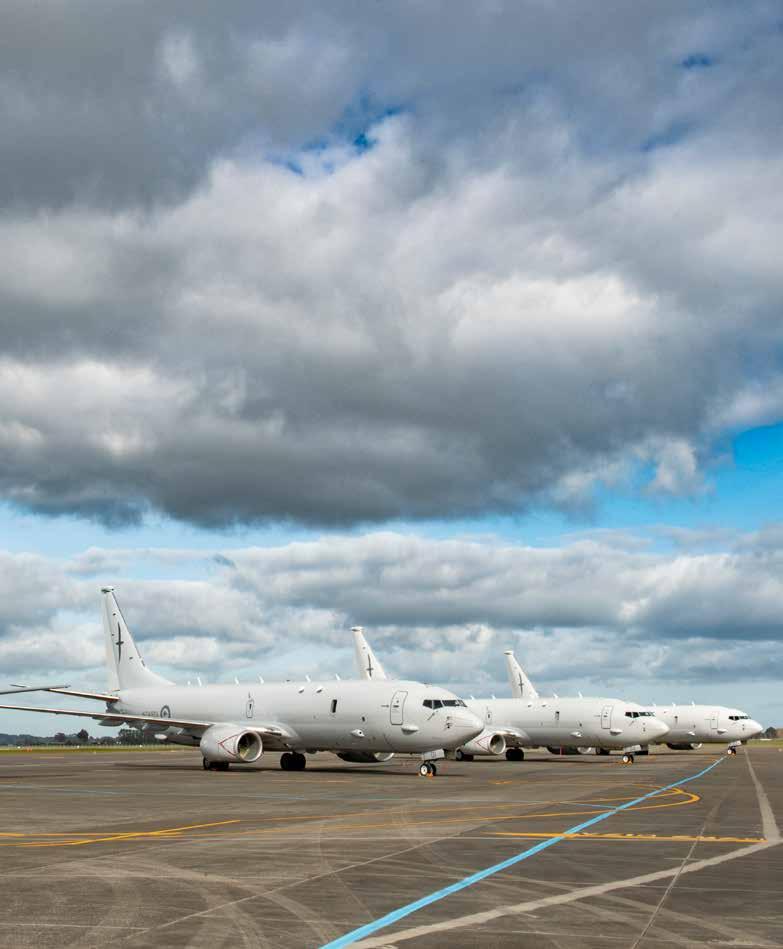
AIR FORCE NEWS #261 | 35
New
PERSON OF THE YEAR 2023

Sailor of the Year • Soldier of the Year • Aviator of the Year Civilian of the Year • Reservist of the Year • Safety person of the Year Outstanding Sports Award • Volunteer of the Year • Cadet of the Year SQNLDR Peter Rule Inclusion Award • Innovation of the Year
CALL FOR AWARD NOMINATIONS
Zealand Defence Force


































































